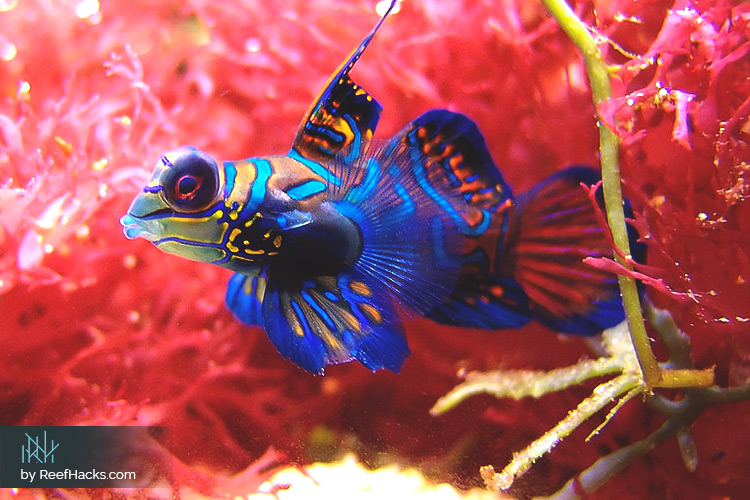In my opinion, the perfect end to any day is curling up with a cup of herbal tea and witnessing life unfold in my saltwater aquarium. As I melt into the vibrant colors and constantly evolving appearance, the worries of the day feel miles away.
Secretly, I’m not just reveling in the beauty of encapsulated nature. I’m waiting to spot my most precious finned friend. Like clockwork, out pokes one of the most beautifully decorated fish I’ve ever encountered.
No, this isn’t a mirage, or the result of too much sleepy time tea. The creature capable of taking my breath away is none other than the famed mandarin goby.
To say I love my mandarin dragonet is an understatement. As my colleagues have put it, I’m obsessed with every delicate feature. Perhaps the most vibrantly decorated reef fish to ever exist, they’re more painting than fish. Mother Nature demonstrates her artistic talents whenever a mandarin goby enters this world.
If you’re not familiar with this mesmerizing creature, prepare for your aquatic life to never be the same again.

Author:
As a lifelong aquarist, Yuliya has an endless curiosity about our underwater universe. After graduating with a bachelor’s in Environmental Engineering, she transformed her passion into a successful career. While working at the Institute of Environmental Protection in Moscow, her passion for saltwater and reef aquariums only increased. Moving to the United States in 2013, Yuliya embarked on another impactful journey by sharing her unprecedented experience for all aquarium hobbyists ... Read More.
While I could prose about the beauty of mandarin dragonet fish for pages, that’s not why I’m here. Plus, there’s no soliloquy powerful enough to capture the otherworldliness of this fish.
Throughout the past several years of caring for these dreamlike creatures, I’ve come across countless aquarist who find them as mysterious to own as they are to observe. Caring for mandarin goby fish, also known as mandarin dragonet, isn’t the easiest task.
It seems the privilege of caring for these dizzyingly beautiful fish comes at a price. No, I’m not talking about a literal price, but rather, the cost of patience and dedication.
For many hobbyists, these fish are as notoriously difficult to keep alive as they are beautiful. However, it doesn’t have to be.
I’ve compiled my copious amount of notes to help even novice saltwater aquarists capture and sustain the magnificent beauty of the mandarin goby. With a little patience and dedication, you too can experience the nightly parade of color and etherial mystery of our world’s most beautiful reef fish.
Easing Into Beauty - Mandarin Goby Quarantine Thoughts.
There you are searching for the perfect mandarin goby. As soon as you think hope is lost, the perfect fish swims up from the bottom of the tank. You know immediately that’s the one.
In a flurry of excitement, you hurriedly finish the transaction and carefully drive back to your reef tank. Images of beautiful evenings spent watching your new fish friend elegantly explore its new home fill your mind.
But, don’t get too excited just yet. Even the healthiest goby should be quarantined. Plopping your new friend immediately into the main tank is the easiest way to end its beautiful life.
Quarantine is especially vital if your tank already has larger copepod-eating occupants. Why? Mandarin goby fish are notoriously slow eaters. Add this with the shock of transitioning homes, and your precious finned beauty may starve.
Maximize the chance of survival by sending your new friend on a little vacation to quarantine land.
Important Note: The necessity of quarantine for mandarin goby’s is a hot topic in reef tank circles. Because these fish are pretty resilient to diseases, you likely won’t need to quarantine for health reasons.
The main purpose of containing new fish is to train develop healthy eating habits. However, if your goby comes from a populated aquarium, quarantine may not be necessary. Use your best judgment when it comes to quarantining these beautiful creatures.
Ideal Mandarin Dragonet Quarantine Tank Setup.
If you feel quarantine is necessary, establishing a healthy tank isn’t very complicated. Essentially, you need the following:
- Appropriately Sized Tank - These fish love space. Try to use an appropriately sized reef tank. In general, nothing smaller than 20 gallons should be used.
- Water Temperature - Just like their main habitat, quarantine tanks should be around 72 to 82 degrees Fahrenheit.
- Water Composition - Maintaining appropriate composition levels is just as important in quarantine tanks as it is in the main tank. Maintain a salinity level between 1.023 to 1.025 and a pH level between 7.9 and 8.4.
- Make It Homey - A stressed goby is a dead goby. Keep them healthy and happy by adding a good sized chunk of established live rock from the main tank.
- Plan In Advance - If you decide to quarantine, plan this in advanced. Ideally, the QT offers the same optimal conditions as the primary habitat.
- Ample Food - Goby’s eat a lot. Keep your new friend healthy by ensuring a constant supply of pods into the QT.
The Introduction of Natural Beauty - Integrating Mandarin Goby Fish.
When the time has come to integrate your goby into the main tank, try to contain your excitement. Integrating a mandarin goby requires astute awareness to prevent shocking the fish.
Begin by filling one side of the tank with ample food pods (more on pod recommendations in a moment). While goby’s are relatively docile and peaceful, coming face-to-face with all the tank’s inhabitants at once can be a shock.
Gently place your goby directly above the pods and away from other tank inhabitants. Eventually, your goby will gain enough confidence to begin exploring his new home.
The Ecosystem of Health and Plump Bellies - Ideal Tank Environments.
Although mandarin dragonet goby’s aren’t delicate fish, they are demanding. They demand the best environment. Fail to satisfy their needs, and you’ll soon have the most beautiful fish corpse. I speak for everyone when I say, that’s not a fun experience.
Prevent premature goby deaths by adhering to a few baseline rules.
Rule #1 - Tank Size.
Goby’s love space! If your tank’s too small, these docile fish can become territorial and become a menace for other tank inhabitants. Keep your well-mannered mandarin goby a positive member of your tank by giving him ample space.
As a general rule, goby’s require a large tank around 50 gallons, minimum. It is possible to sustain a healthy goby in a tank as small as 30 gallons, but bigger really is better.
Rule #2 - Established Coral Reefs.
You should already have an established reef with thriving live rocks. This is paramount for success. They love hiding spaces, so make sure the tank features dynamic areas where the goby can retreat from the hustle-and-bustle of aquarium life.
Rule #3 - Pair Mandarin Goby’s Carefully.
In larger tanks, it’s possible to have two same-sex goby’s live in peace. However, proceed with caution. These little guys are notoriously territorial toward their own species. This being said, male/female combinations tend to work well in both smaller and larger tanks.
When adding new inhabitants to the reef tank, do so slowly. These shy fish aren’t too fond of new faces, but they warm up nicely.
Life’s a Buffet for Mandarin Goby Fish - Essential Feeding Guidelines.
Mandarin goby’s love to eat. Actually, they eat all the time.
I remember my first goby and was shocked at the amount of food he went through daily. The secret to a long, healthy life is to ensure their food supply never dwindles. However, this is a challenge for many aquarists.
The two key elements to always remember when caring for mandarin goby’s are:
- #1 - Constant food source availability.
- #2 - Primary food source is in the form of enriched pods, but with variable options thrown in the mix.
If you’ve spent any time researching mandarin dragonet goby dietary habits, then you realize these fish aren’t the easiest to satisfy. However, I’ve cracked their culinary code. Here are my findings:

Live Copepods Are Recommended, But Not Exclusively.
You’d think after all the work you put into creating the ideal habitat, a mandarin goby would graciously consume food. Unfortunately, goby’s are notoriously finicky eaters. In most cases, they won’t eat unless their meal is perfect.
So, what do you do when you goby wants a five star meal, but you only know how to make fast food? The solution isn’t as complex as you think.
Most owners recommend live copepods, which are living food similar to what’s available in the wild. Goby fish will eat themselves into a frenzy over copepods, which are living food sources typically grown in a refugium.
Don’t have a refugium, or your setup isn’t making ample pod supplies? It’s okay, you have options! I personally recommend buying pods from your local fish supply store so you can see them and confirm that they are active and in good density. However, if this isn’t an option, there are several online retailers known for their high-quality copepods.
If you choose to purchase pods online, I recommend PolypLab, amazing quality pods with epic density, and while you shop for pods be sure to get the Reef-Roids as well.
Your corals will thank you twice !
In my experience, training mandarin goby’s to consume frozen food wasn’t as difficult as it sounds. However, I always supplement my tank with phytoplankton. Dosing phytoplankton helps support the natural population of food, which has kept my goby happy and healthy for longer than I can remember.
When feeding time comes, make sure to show your goby a little extra love. Eventually, your live rocks can support massive copepod colonies, which reduces the frequency of feeding.
As long as you supplement the tank with phytoplankton and closely monitor your mandarin goby’s eating habits, the dreaded meal requirements swiftly turns into a pleasurable experience.
Mandarin Goby Care - Simplified for Simply Beautiful Reef Tanks.
It’s no secret mandarin dragonet goby’s aren’t the easiest to care for. Because of its mesmerizing beauty, many novice saltwater aquarium hobbyists flock to their vibrant colors like a moth to the flame. However, without learning the intricacies of this mysterious fish, their beauty is often short-lived.
Thankfully, it doesn’t have to be this way. Following the guides outlined above, and continuing your education, can transform a once-complicated care list into one that’s simply easy.
As always, we’re here to help you along your reef tank journey. Feel free to send us a message and together, let’s safeguard the health and beauty of these magical creatures!
by Yuliya Ivanova for ReefHacks.
Photography by Joachim S. Müller and Jay Clark, NOAA NMFS AFSC




